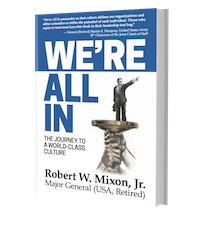Culture—the way people think, behave, and work in an organization—is difficult to control. Thankfully, that’s not what our model asks of leaders. Leaders of an “All In” culture seek to influence culture versus controlling it. Because we humans are complex animals, developing (and maintaining) a culture of excellence is time-consuming, challenging work. Leadership is the key ingredient for success.
Recognize the absolute power of growing a Level 5 culture. The qualities of Level 5 individual leadership must transfer into the entire organization— and that’s where the deliberate application of The Big Six® comes in. At the various levels of leadership (front line, organization, and enterprise), teams of leaders embrace and collaborate to implement these principles. There must be a deliberate, focused effort to bring these qualities to life. And it will take time.
Connecting the dots from a loosely-tied collection of individuals (Level 1) through a confederation of somewhat committed people led by a few caring, dedicated leaders (Level 3), to a world-class culture of excellence where everyone is “all in” (Level 5) is not a linear progression.
Like the journey to individual leader excellence, the road to having a culture of “All In” will have setbacks. Changes in leadership, market conditions, growth (especially acquisitions) will all adversely affect the cultural growth of your organization—at least initially. Your task as leaders of the enterprise is to understand these dynamics at work and take action to mitigate, then overcome, their adverse effects.
The resiliency of the Level 5 culture is what sets it apart. Resiliency is the linking of components so they can reconfigure and adapt to changing conditions. That’s a significant distinction in what separates enduring cultures from the temporary ones.

Success breeds complacency. Complacency breeds failure. Only the paranoid survive.
— attributed to Andrew Grove, former president of Intel
A healthy paranoia can only exist in a healthy framework if the team members believe they can handle uncertainty. Resiliency gives them that confidence.
In my experience, most organizations need some help to navigate these waters. Having a meaningful relationship with an experienced, dedicated consultant team is a tremendous asset in making a successful journey to cultural excellence—in bringing the Level 5 culture to life. I’d recommend Level Five Associates (of course!), and realistically the key is to develop a long term relationship of trust with your consultant partner.
It’s like having a doctor you believe in. When I needed total knee replacement on both knees a few years ago, I turned to my orthopedic surgeon and next-door neighbor, Dr. Mike Niles, and asked for help. His skill changed my life—but I also trusted him and followed his guidance.
With an organizational consultant, you’re doing much of the same thing with the life of your company. Take the time to develop this relationship.
 This blog is based on material from my book “We’re All In.” You can get a copy of the first chapter for free here.
This blog is based on material from my book “We’re All In.” You can get a copy of the first chapter for free here.
If you’d like a full copy of the entire book, you can get it here.
Enjoy the journey!
Did you find this blog post beneficial? If so, please share it with your audience using one of the choices below. It’ll just take a second, but could improve someone’s work habits for a long time to come.





